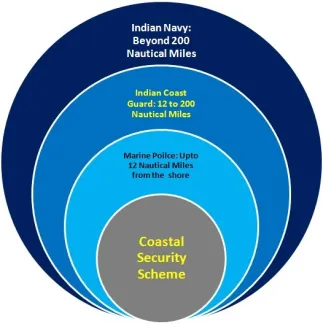COASTAL SECURITY

Maritime Security is the means by which a maritime nation defends itself and its territorial waters against external threats, sometimes in conjunction with closer co-operation national security.
The importance of this system in respect of protecting critical installations, combating maritime crime national security and safety as well environmental aspects cannot be overemphasised.
For proper as well as efficient working of national maritime force and to gain actual control over the marine forces.
ESSENTIAL COMPONENTS OF A COASTAL SECURITY SYSTEM:
Physical Infrastructure: The elements of a strong coastal security apparatus include Coastal Surveillance Systems,
Coast fortification and sea walls: Coast Guard, marine law enforcement agencies and intelligence units; coastal communities for an early warning / reporting systems.
Integrated Maritime Domain Awareness Systems, Advanced Analytics And Unmanned Vehicles Integrated maritime domain awareness systems with advanced analytics and unmanned vehicles increase the effectiveness of coastal security systems.
International Cooperation: Regional cooperation, regional information exchange, and joint operations are required to tackle transnational maritime crime and threats.
NEED
Safeguarding Essential Infrastructure: Ports, harbour and offshore installations are essential for the economy of a country as well its security.
These coastal security initiatives are the mechanisms to provide external and internal threats that resulting in terrorism, sabotage piracy can protect these assets.
Maritime Task: Piracy, drug trafficking, illegal fishing and other criminal activities remain major threats to maritime security.
These threats are effectively countered by coastal security systems, using increased vigilance and sea patrolling through international cooperation.
Furthering National Security: It is essential to guard the national frontiers, and controlling territorial waters access or ability of coastlines can thwart illegal immigration or smuggling. To succeed in this mission, the coastal security systems are primary element.
Conservation of the Marine Environment: The marine environment is constantly under threat from pollution incidents, illegal dumping and overfishing.
These measures would be useful to prevent these actions, which also benefits the maintenance of marine ecosystems with systems for coastal security.
Reaction to a disaster: Natural disasters like hurricanes and tsunamis are potentially devastating for coastal areas. The preparedness, response and recovery mechanisms for disasters can be highly benefited from these coastal security systems.
PROBLEMS AND ISSUES
Resource Constraints: Coastal security systems would require large infrastructure, manpower, technology and maintenance investments. Many orgs are restrictive in their security approach, to the point that it becomes toothless and adversaries can worm into vulnerabilities.
Jurisdictional Complexities: Maritime boundaries and overlapping jurisdictions between nations can lead to confusion around where certain operations are able to take place, forming the basis of many problems associated with information coordination.
Unambiguous sector definitions along with collaborative mechanisms are imperative for better inter-agency alignment at the domestic and international levels.
Technological limitations: Coastal surveillance systems have limitations due to technological burden, and are essentially unable to cover large-scale area such as remote or poorly charted waters.
Moreover, new technologies such as drone swarms and cutting-edge encryption present difficulties for detecting or intercepting them. On another topic, technology upgrades and adaptation is key to staying equals with constant evolve in threats.
Data Integration and Analysis: large amounts of data are generated from diverse sources through the various coastal security systems. This makes examining and integrating this data effectively to spot anomalies or suspicious fraud activities in real time quite challenging.
Data analytics play a crucial role in enabling maximum utilization of collected data alongside artificial intelligence and human resource.
Corruption and Weak Governance : Criminal elements can infiltrate security agencies in regions with weak governance or high levels of corruption, abusing regulatory frameworks or exploiting them by finding loopholes.
To ensure that the coastal security systems remain robust and effective, it is essential to strengthen governance, combat corruption and uphold rule of law.
Climate Change and Coastal Security: Climate change impacts such as rising sea levels together with seriously unpredictable weather events, represent another danger to coastal security.
To confront these changing threats, it is necessary to alter infrastructure requirements and improve surveillance systems, as well as review emergency response protocols.
Balancing Between Security Needs and Economic Activities: The importance of reconciling maritime security to deal with terrorism is that it does not misdevelop controlling movements against commerce yet .
at the same time allowing legitimate economic activities in open seas. Excessive security restrictions can inhibit economic development and trade, whereas poor controls expose vulnerabilities. Its important to strike the right balance
Public Awareness and Cooperation: Coastal security can be improved only if the public is aware of (a) the trade-offs it faces when deciding what level of coastal defence to support, gaining a broader understanding why fisheries rules are enforced across territorial waters .
to securing our country from terrorism; as farfetched it may sound but its true. According to the report, "Surveillance and enforcement would have effectiveness run-through community contribution.
Tackling Transnational Crime: Maritime offences often ignore state borders. Adequately addressing these will be extremely difficult without significant international cooperation, sharing of information and collaboration on operations.
Legal frameworks have to be harmonized and cross-border cooperation needs to work more effectively in the fight against transnational maritime crime.
GOVERNMENT INITIATIVES
1.INSTITUTIONAL FRAMEWORK:
Indian Coast Guard (ICG)~ Main agency for coastal security, ICG plays an important role in patrolling territorial waters to thwart smugglers and illegal immigrants from infiltrating the coasts as well as protect critical infrastructure.
Marine police: Coastal states and union territories have their own marine police which are responsible for law enforcement along our coastlines.
National Committee on Coastal Security (NCCS) - NCCS is a high level committee headed by Cabinet Secretary giving policy direction and guidance in coastal security matters.
2.INFRASTRUCTURE DEVELOPMENT:
Coastal Surveillance Network (CSN) - A network of radars, Automatic Identification Systems (AIS), and other sensors deployed along the Indian coastline in order to monitor maritime activities and detect any suspicious movement.
Coastal Police Stations[M8]: Establishment of dedicated coastal police stations at key locations to increase law enforcement presence and improve responsiveness in maritime incidents. Fill the Gap in Radar Coverage .
Enhance Monitoring Capability: Additional coastal radar stations - constructing more of these GPs to plug surveillance holes and defence monitoring deficiencies.
3.TRAINING AND CAPACITY BUILDING
Indian Maritime University (IMU) - a university established to impart specialized training in maritime safety, security and administration for marine personnel engaged on port duties.
Regular training programs are conducted to provide personnel necessary skills and knowledge in maritime law enforcement, search and-rescue operations and combat against marine threats .training programs for ICG & Marine Police Personnel.
International cooperation: Cooperation with foreign states and international organizations: Exchange of information on best practices; Joint training statements
4.TECHNOLOGICAL ADVANCEMENTS:
AIS Satellites: These satellites keep an eye on the activities of ships in truly remote areas far out of radar range from any shore station.
Unmanned Aerial Vehicles (UAVs): Deploying drones for surveillance and reconnaissance missions to effectively monitor huge tracts of the coastline Unmanned Aerial Vehicles (UAVs)
Artificial Intelligence (AI): The use of AI algorithms to better analyse data and find patterns will help identifying suspected vessels/activities much faster.
5.COMMUNITY ENGAGEMENT:
Coastal Communities sensitization programmes: To heighten the awareness level of maritime security threats among coastal communities and to encourage them in reporting suspicious activities, as well as involving fringes them from beach patrols.
Formation of Coastal Security Committees: Creation of local bodies capable for bringing together officials from agencies, fisheries and coastal communities to deliberate on the security concerns as well work in towards integrated efforts.
6.REGIONAL COOPERATION:
Information sharing and coordination with neighbouring countries: We will share the input data with maritime security agencies of neighbouring countries to operationalize joint patrolling activity for tackling transnational maritime crime.
Regional maritime security initiatives: Actively participating in regional forums such as the Indian Ocean Naval Symposium (IONS) and the Regional Cooperation Agreement on Combating Piracy and Armed Robbery
THE WAY FORWARD
1.BUILDING THE INSTITUTIONAL ARCHITECTURE
Empowering of coastal states: Giving coastal states more power and resources to efficiently handle their security in the maritime domain.
Improving Inter-Agency Coordination: Setting up strong connecting material for the exchange of facts and geared operations amongst exclusive firms involved in coastal security.
Leveraging Technology: Use of cutting-edge advancements such as AI, Big Data Analytics and Unmanned systems for a more increased situational awareness which will help in better analysis of the data and also addressing routine tasks.
Promoting Public-Private Partnerships: Emphasis on encouraging joint ventures, where private companies team up with government agencies in the area of coastal security infrastructure development and technology deployment.
2.INVESTING IN HUMAN RESOURCES:
Capacity Building: Offering specialized course to the ICG and marine police personnel in advanced maritime law enforcement, search & rescue operations [SAR], cyber security and intelligence collection.
Promotion of R&D: Investment in Research and known R&D organizations,
Universities for development of coastal technologies/solutions independently.
Reach Out to Coastal Communities: Encourage greater involvement by coastal communities in maritime security efforts through training, resources and incentives.
3.IMPROVES MARITIME DOMAIN AWARENESS:
Implementation of Additional Sensors, Radars and Cameras: This strategy would fill existing gaps in the CSN by deploying sensors across remote areas as well covering blind spots not being picked up.
Forging Integrated Data Platforms: Creating seamless and integrated data platforms which collate feed from disparate sources such as coastal radars, AIS, satellite imagery intelligence inputs or social media to offer a single window maritime situational view.
AI Use Cases: Validating and managing security features through data analysis with the help of AI algorithms drastically simplifies identification of irregularities, suspicious patterns to predict threats faster.
4.BOOST INTERNATIONAL COOPERATION:
Strengthened Regional Cooperation: Improved regional cooperation through increased intelligence sharing, joint patrols, and synchronized operations with Belize's neighbours to control the flow of transnational crime including piracy.
Engaging in Multilateral Initiatives: Participating actively in international forums and bodies such as IMO, IONS, ReCAAP etc., with a view to exchanging best practices and contributing towards policy evolution; Seeking assistance from other countries when required.
5.ADDRESSING EMERGING CHALLENGES:
Cyber Security - Building resilient cyber security frameworks and deploying cyber defence capabilities to secure vital maritime infrastructure from cyber threats.
Climate Change Adapting coastal security strategies to rising sea levels, erosion and more extreme weather .
Climate Security Coach. Emerging Technologies: Keeping an eye on emerging technologies such as autonomous vessels, underwater drones and maritime blockchain applications to evaluate their effect with respect to coastal security so that preventive measures can be taken.

-1721391937657.png)

